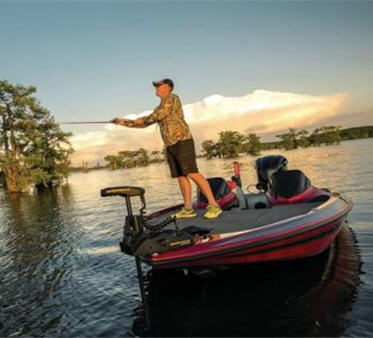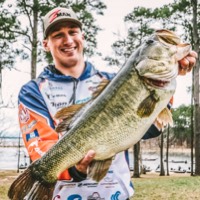- BassEdge.com - Pursue Your Passion
The Guide to Beginner Bass Fishing On a Fly Rod

THE EDGE – 336 Greg Dipalma
September 15, 2020
How to Choose the Right Trolling Motor for Your Boat
October 1, 2020Posted by: Bass Edge Radio Fan, Nick Wharton
Bass are the most prevalent game fish in the US. Being found in 48 out of the 50 states. So it’s always surprised me how they have not become more popular. Trout are finicky and delicate, but are also beautiful, fun, and can be found in great places. However, not everyone has easy access to a trout stream.
Everyone has access to a bass pond, lake, river, stream, creek or wherever else these fish can get a foothold. So, if the nearest trout stream is too far away from you and you want to go out and nab some fish on the fly then chances are there’s a bass somewhere within 20 minutes of where you live.
So, if you’re interested in figuring out how to find bass and how to fish for them with a fly rod then check out the article below. We’re going to cover different techniques, destinations, as well as the best flies for bass fishing.

Why Try Bass Fishing with a Fly Rod
First of all, not all fly rods are created equal. Some are more geared towards targeting trout, while others are meant for larger game. Usually bass fly rods are around the 6-weight to 8-weight range. Check out my guide to The Best Fly Rods For Bass if you’re new to the sport of fly fishing and need help choosing a good rod.
One of my favorite fish to chase with a fly rod is largemouth and smallmouth bass. Both fish put up a great fight and you can use several different flies to catch them. On top of this they are both fun and challenging.
Luckily, both fish will eat similar flies. So, if you live in an area that contains both largies and smallies then you’ll be just fine bringing one fly box with you to either the lake or the river.
Smallmouth is renowned for being pound for pound one of the best fighting game fish. If you don’t have the proper tippet on then an average sized river smallie could easily put you on the reel and take you for a ride, or just snap you off.
I had a very large smallmouth give me a ride around the river one morning. Only once I got it close to my kayak did it decide to put it one last run and break me off when it was just a hair out of netting distance.
Now, as great as smallmouth are you shouldn’t think any less of largemouth. While they may not put up as sustained of a fight as smallmouth, they can have some truly incredible runs that can leave your drag zipping and you’ll be wondering if you have a bass or a redfish on the other end.
So, below we’re going to go over some flies and techniques that will help you get out and catch some more bass with your fly rod. Check them out and see which ones are going to work best for you!
Best Flies for Bass Fishing
Both largemouth and smallmouth will take the same flies. The biggest difference is the size of the fly. Since smallie shave smaller mouths you might want to downsize that streamer or popper pattern. The opposite applies to largemouth.
Poppers
One of the reasons we all fell in love with fly fishing is all of the topwater flies we get to throw, and bass fishing is no different. One of the best parts about this sport is watching a bass come to the surface and blow up your popper pattern in the early mornings. These fish are not delicate.
With largemouth the word delicate should rarely be in your vocabulary. More often than not you’re going to be fishing hard and using that fly to create a wake and make some noise on the water. This entices the fish and brings them in for what they think is an easy meal.
When using a popper you want it to land hard on the water and then alternate between slow and quick pops on your fly.
Clousers/Baitfish imitations
Bass love chasing after different types of panfish, shad, and even smaller bass. So, if you’re fishing during a time when these types of prey are most active then a baitfish imitation will be great and is going to net you a great day on the water.
Try to match the color and size to the local forage in the body of water. White with chartreuse is a great catch all and can be used successfully in most bodies of water. Be prepared for the strike to occur on the fall and give a hard pull on the line to set that hook in the corner of the mouth.
Crawfish Imitation
In shallow lakes and rivers, you can easily use a crawfish imitation on floating line. Allow it to sink and then give it the occasional pop back to either your spot-on land or from your boat.
A crawfish might be the best fly for both largemouth and smallmouth. Both fish love eating these little creatures and they are a must have in your fly box.
Techniques for Bass Fishing
I’m now going to show you some of my favorite bass fishing techniques. Below, I’m going to go over each season to show you how you can catch bass year round on a fly rod. Check it out!
Pre-Spawn
Bass are very active during the time of the year right before they spawn. This varies in different parts of the country but for bass it’s usually when the water temperature starts to creep out of the 40-degree mark and begins to hang around the 50’s.
Fish are looking to add some weight since they’ve just survived the winter and are actively looking for food. So, throwing a slow moving streamer is a great way to locate bass. Then once you’ve found them you can throw crawfish or slower patterns.
Spawn
During the spawn fish are on their beds protecting their eggs. I usually do not like to disturb nesting fish during this time so I’m usually throwing flies to Brook Trout in the mountains. However, if you find that your fishing options are limited then I understand.
You can catch them by locating the beds in the shallow parts of channels and points. Casting a crawfish fly and dragging the fly across or near their beds will instigate a strike. Once caught, release the bass as close to its bed as possible.
Keep in mind that not all fish are spawning at the same time. So, I would encourage anglers to target pre-spawn fish. That way you don’t have to disturb fish on their beds.
Post Spawn
During this time the female bass have left the nest and now the male bass are left remaining to protect their fry. The females are usually going to be in deep water, or they can be found in undercuts of a river. Making them difficult to find and catch.
The females aren’t gone for long though. They usually start to make their way back out after a week or two. If you want to target males on their nest use the technique mentioned above. Otherwise, you’ll most likely need some sort of sinking line to find females if you plan on fishing in lakes.
Summer
Morning, evening and night will be some of the most productive times for bass. This is because of the cooler water temperature and the low light conditions. Making them ideal to catch bass on topwater.
Look for weed lines, structures, drop-offs, or grass. Use a popper around these pieces of structure. A shallow running baitfish imitation can also be the hot fly.
If you plan on fishing in the middle of the day then be prepared to go subsurface. Crawfish and deep running baitfish imitations will work best. Pick out boulders, drop offs, sunken trees or eddies in rivers for fish. For largemouth you’ll want to throw to drop-offs, and anywhere that might have shade where fish could be hiding out in cooler water.
Fall
Fish are very active during the fall. They’re looking to fatten up for the winter time and will be chasing baitfish. Look to throw a lot of streamer patterns and don’t forget to try out a few topwater flies. If the bite is slow you could always throw the old trusty crawfish fly.
Winter
Winter is different all over the country. In the northern states where water will freeze over you won’t be doing much fly fishing for bass. In the southern half of the country it can be possible to go out and catch bass on a fly rod.
Typically, you’ll be throwing flies with full sinking line and crawling the bottom with a wooly bugger, crawfish or anything else you can think of. Winter is slow, but fish can be caught that time of the year.
Best Destinations
Southern California, the rest of the southwest and the southeast are known as hotbeds for big time largemouth fishing. These fish are eating and growing year-round. Allowing them to grow to very large sizes. Lake Guntersville in Alabama, Lake Osceola in Florida, Lake Sam Rayburn in Texas, and Clear lake in California are all great spots to check out.
Smallmouth is probably best known as a northern fish. However, don’t count out the South. There are some strong smallmouth fisheries in the southern half of the country. Check out the New River in Virginia, The Black River in Arizona, Lake Erie in Ohio and Pennsylvania, Lake Champlain in New York, and Lake Ontario.
Conclusion
Bass fishing with a fly rod is something that should catch on as the sport continues to grow. Many people don’t even associate fly fishing with bass fishing.
So, if you’re looking to get started in this up and coming sport then hopefully the article above gave you everything you needed to get started. Now head on out and hit the water!


